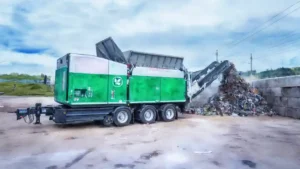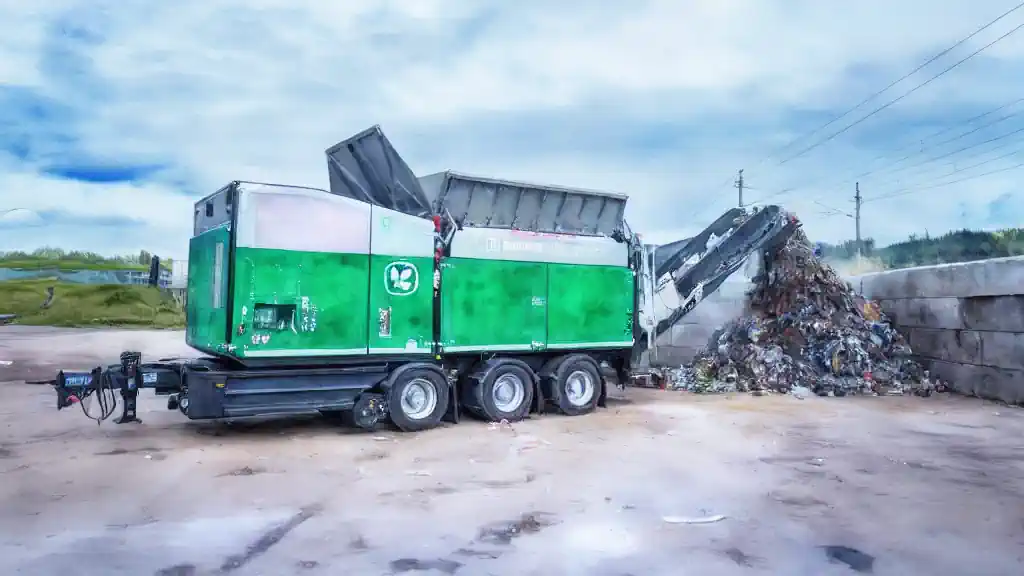Komptech Terminator Shredder System: A Comprehensive Technical Review
The Komptech Terminator is a versatile shredder system, from a well-established and respected manufacturer, designed for processing a wide range of materials, including food waste. As a neutral assessor, I will provide a comprehensive overview of the Terminator’s features, performance, and suitability for food waste processing applications.
Key Takeaways
- The Terminator is a robust and powerful shredder capable of handling a variety of materials, including food waste, with high throughput rates.
- The shredding process can generate microplastics, which is a consideration when using this equipment for food waste processing, particularly for applications such as anaerobic digestion.
- The Terminator’s versatility and customizable configuration make it a versatile choice for various waste processing operations.
Shredder Design and Functionality
The Komptech Terminator is a mobile or stationary shredder system that utilizes a twin-shaft design to effectively break down and process a wide range of materials. The shredding action is achieved through the counter-rotating shafts, which are equipped with a series of cutting tools and knives.
One of the key features of the Terminator is its ability to handle a diverse array of input materials, including municipal solid waste, commercial and industrial waste, and, importantly for this review, food waste. The shredding process can effectively break down these materials into smaller, more manageable fractions, making them more suitable for further processing or disposal.
Microplastic Considerations
It is important to note that the shredding process employed by the Terminator can generate microplastics, which are small plastic particles less than 5 mm in size. This is a relevant consideration when using this equipment for food waste processing, particularly in applications where the shredded material is intended for anaerobic digestion.
In anaerobic digestion systems, the microplastics generated by the shredding process can pass through the digester and be present in the digestate output. This can be a concern, as microplastics can have potential environmental and health implications if not properly managed.
Suitability for Food Waste Processing
The Terminator’s ability to handle food waste makes it a potential choice for operators seeking to process this type of material. However, the generation of microplastics during the shredding process should be carefully evaluated and considered, especially when the shredded material is intended for anaerobic digestion.
It is recommended that operators thoroughly assess the impact of microplastics on their specific anaerobic digestion system and take appropriate measures to mitigate any potential issues, such as implementing additional separation or filtration steps.
Customization and Versatility
The Komptech Terminator is available in various models and configurations, allowing operators to select the unit that best suits their specific waste processing requirements. This customization includes options for engine power, rotor design, and other features that can be tailored to the user’s needs.
This versatility makes the Terminator a versatile choice for a range of waste processing applications, including the handling of food waste. However, it is crucial to carefully evaluate the microplastic generation and its implications in the context of the intended use case.
Conclusion

The Komptech Terminator is a robust and versatile shredder system that can effectively process a variety of materials, including food waste. However, the generation of microplastics during the shredding process is a significant consideration, particularly when the shredded material is intended for anaerobic digestion.
Operators should carefully assess the potential impact of microplastics on their specific waste processing operations and implement appropriate mitigation strategies to ensure the effective and sustainable management of food waste.
FAQs
Q: Does the Terminator produce microplastics during the shredding process?
A: Yes, the shredding action employed by the Terminator can generate microplastics, which are small plastic particles less than 5 mm in size. This is an important consideration when using the Terminator for food waste processing, particularly for applications such as anaerobic digestion.
Q: How can operators mitigate the impact of microplastics generated by the Terminator?
A: Operators can consider implementing additional separation or filtration steps to remove microplastics from the shredded material, especially if the material is intended for anaerobic digestion. This can help minimize the presence of microplastics in the digestate output.
Q: Is the Terminator suitable for food waste processing for anaerobic digestion?
A: The Terminator can be used for food waste processing, but the generation of microplastics should be carefully evaluated and addressed, especially when the shredded material is intended for anaerobic digestion. Operators should assess the specific requirements of their anaerobic digestion system and implement appropriate mitigation strategies to manage the microplastic content.
Q: What are the key advantages of the Terminator compared to other shredder systems?
A: The Terminator’s key advantages include its versatility in handling a wide range of materials, high throughput rates, and customizable configuration options.
Manufacturer of waste processing technology
Industry Sector: Environmental Technology
Business Location: Styria Austria
Address:
Komptech GmbH
Kühau 37
8130 Frohnleiten,
Austria
Email: info@komptech.com
Phone: +43 3126 505 – 0
Website:
Komptech : www.komptech.com
Opening Hours:
8am to 5pm Weekdays

